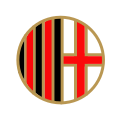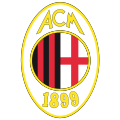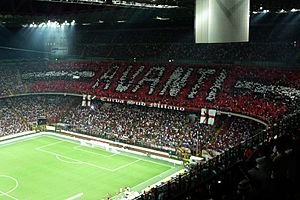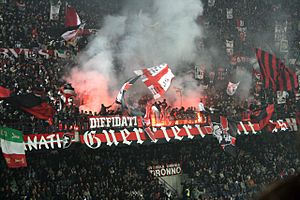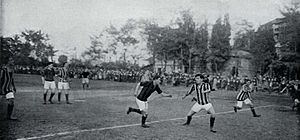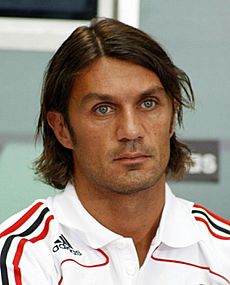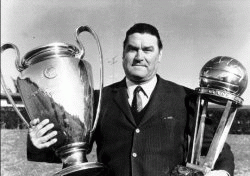AC Milan facts for kids
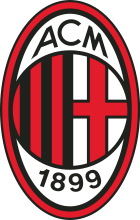 |
|||
| Full name | Associazione Calcio Milan S.p.A. | ||
|---|---|---|---|
| Nickname(s) | I Rossoneri (The Red and Blacks) Il Diavolo (The Devil) |
||
| Founded | 18 December 1899, as Milan Foot-Ball and Cricket Club | ||
| Ground | San Siro | ||
| Capacity | 75,817 (limited capacity) 80,018 (maximum) |
||
| Owner | RedBird Capital Partners (99.93%) Private shareholders (0.07%) |
||
| Chairman | Paolo Scaroni | ||
| Head coach | Massimiliano Allegri | ||
| League | Serie A | ||
| 2018–19 | Serie A, 5th of 20 | ||
|
|
|||
AC Milan is a famous Italian professional football club from Milan, Lombardy. It was started in 1899 and plays in Serie A, which is the top football league in Italy. For many years, Milan played its home games in different places before moving to its current stadium, the San Siro, in 1926. This stadium is the biggest in Italian football and has been shared with their rivals, Inter Milan, since 1947.
Milan has a big rivalry with Inter Milan, and their matches are called the Derby della Madonnina. This is one of the most watched football rivalries in the world. Milan has almost always played in Serie A, except for two seasons in the early 1980s.
A very important time for the club was when Silvio Berlusconi was president for 31 years. During this period, Milan became one of the strongest and most successful clubs in Europe. They won 29 trophies, including many Serie A titles and UEFA Champions League cups. In the 1991–92 season, Milan made history by winning the Serie A title without losing a single game. Many great players who won the Ballon d'Or (an award for the best player in the world) have played for Milan. In 1988, three Milan players – Marco van Basten, Ruud Gullit, and Frank Rijkaard – were the top three players for the Ballon d'Or, which was a first for any club.
Milan is known as one of the most successful football clubs in the world because of all the trophies they have won. In Italy, they have won 19 league titles, 5 Coppa Italia cups, and 8 Supercoppa Italiana cups. Internationally, Milan is Italy's most successful club. They have won the European Cup/Champions League seven times, which is the second-highest number of wins in that competition, only behind Real Madrid. They have also won five UEFA Super Cups, two UEFA Cup Winners' Cups, two Latin Cups, three Intercontinental Cups, and one FIFA Club World Cup.
Milan is also one of the richest football clubs in Italy and worldwide.
Contents
Club History
How Milan Started (1899–1950)
AC Milan was founded as Milan Foot-Ball and Cricket Club in 1899 by an English person named Herbert Kilpin. The club says it was founded on December 16th, but some history suggests it might have been a few days later, around December 18th. The exact date is still debated because the club's original papers are lost.
To honor its English beginnings, the club kept the English spelling of the city's name, "Milan," instead of the Italian "Milano." Milan won its first Italian championship in 1901. They then won two more in a row in 1906 and 1907. The club was very successful in its first ten years, winning several important trophies.
In 1908, Milan had a disagreement about signing foreign players. This led to a split, and another Milan-based team, F.C. Internazionale, was formed. After this, Milan did not win a domestic league title again until 1950–51.
Returning to Success (1950–1970)
The 1950s saw Milan become a top team in Italian football again. They had a famous Swedish trio of players: Gunnar Gren, Gunnar Nordahl, and Nils Liedholm. Milan won the Scudetto (Italian league title) in 1951, 1955, 1957, and 1959.
This decade also brought Milan's first European successes. They won the Latin Cup in 1951 and 1956. Milan was also the first Italian club to play in the new European Cup in the 1955–56 season. They reached the final two years later, but lost to Real Madrid.
The 1960s started with the debut of Milan legend Gianni Rivera in 1960. He played for the club for 19 seasons. In 1961, Nereo Rocco became the new coach. Under him, Milan immediately won a Scudetto in 1961–62. The next season, they won their first European Cup by beating Benfica in the final. This success was repeated in 1969, with a 4–1 win over Ajax in the final. They also won the Intercontinental Cup that same year. During this time, Milan also won its ninth Scudetto, its first Coppa Italia, and two European Cup Winners' Cups in 1967–68 and 1972–73.
Winning the 10th Scudetto and Tough Times (1970–1986)
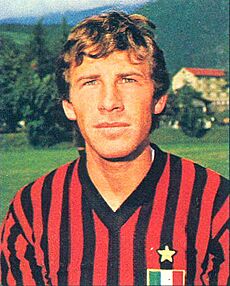
In the 1970s, Milan was trying to win its 10th Serie A title, which would allow them to add a special star to their jersey. For three years in a row (1971, 1972, and 1973), Milan finished second in the league. Finally, they achieved their goal in 1979. That same year, Gianni Rivera retired, and Franco Baresi started his first full season with the club.
After this success, the team went through a difficult period. In 1980, the club was involved in a betting scandal where players and officials were accused of fixing matches. As a punishment, Milan was sent down to Serie B (the second division) for the first time. Milan quickly won the 1980–81 Serie B title and returned to Serie A. However, they were relegated again a year later in 1982. In 1983, Milan won the Serie B title for the second time in three seasons and returned to Serie A, finishing sixth in 1983–84.
Berlusconi's Era of Glory (1986–2012)
On February 20, 1986, businessman Silvio Berlusconi bought the club and saved it from financial trouble. He invested a lot of money, hired a talented manager named Arrigo Sacchi, and signed amazing Dutch players like Ruud Gullit, Marco van Basten, and Frank Rijkaard. These Dutch stars, along with Italian players like Paolo Maldini, Franco Baresi, and Roberto Donadoni, made the team very strong.
Under Sacchi, Milan won its first Scudetto in nine years in the 1987–88 season. The next year, the club won its first European Cup in two decades, beating Romanian club Steaua București 4–0 in the final. Milan won the title again the next year with a 1–0 win over Benfica. This Milan team from 1988–1990 was nicknamed the "Immortals" and is considered one of the best club teams of all time.

After Sacchi left in 1991, former player Fabio Capello became manager. His team won three Serie A titles in a row between 1992 and 1994. During this time, they had an incredible 58-match unbeaten run in Serie A, earning them the nickname "the Invincibles." They also reached the UEFA Champions League final three times in a row (1993, 1994, 1995). One of Milan's most famous matches was their 4–0 win over Barcelona in the 1994 Champions League final. Capello's team won the 1995–96 league title before he left. In 1998–99, Milan won its 16th championship during the club's 100th anniversary season.
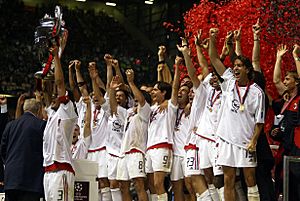
Milan's next successful period came under another former player, Carlo Ancelotti. He became manager in November 2001 and led Milan to the 2003 Champions League final, where they beat Juventus on penalties to win their sixth European Cup. The team then won the Scudetto in 2003–04. They reached the 2005 Champions League final but lost to Liverpool on penalties, even though they were winning 3–0 at halftime. Two years later, the two teams met again in the 2007 Champions League final, and Milan won 2–1, lifting the trophy for the seventh time. The team then won its first FIFA Club World Cup in December 2007. In 2009, Ancelotti left the club.
During this time, the club was involved in the Calciopoli scandal, where some teams were accused of fixing matches. Milan was initially punished with a points deduction, but this was reduced after an appeal, allowing them to stay in the Champions League.
After the Calciopoli scandal, local rivals Internazionale dominated Serie A. However, with strong players like Zlatan Ibrahimović, Robinho, and Alexandre Pato, Milan won the Scudetto again in the 2010–11 Serie A season. This was their first league title since 2004 and their 18th overall.
Changes and Recent Success (2012–Present)
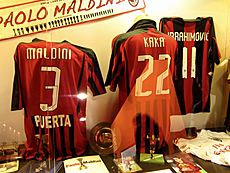
After winning their 18th Scudetto, the club's performance declined for a few years. Milan did not qualify for European competitions for some time. The only trophy they won was the 2016 Supercoppa Italiana under coach Vincenzo Montella, beating Juventus in a penalty shootout.
In 2017, the club was bought by a Chinese investment company. However, the new owner faced financial difficulties, and in July 2018, an American investment firm, Elliott Management Corporation, took control of the club.
In November 2017, Montella was replaced by former player Gennaro Gattuso as coach. Milan qualified for the 2018–19 UEFA Europa League but was initially banned by UEFA due to rules about financial fair play. This decision was later overturned after an appeal. Despite a good season under Gattuso, Milan missed out on Champions League qualification by one point. Gattuso then resigned. In June 2019, Milan was again excluded from the 2019–20 UEFA Europa League for financial fair play violations.
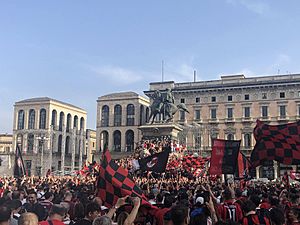
After a short period with Marco Giampaolo as coach, Stefano Pioli was hired in October 2019. After the league restarted following the COVID-19 outbreak, Milan went on a 10-match unbeaten streak. This led to Pioli's contract being extended. In his first full season, Pioli led Milan to a second-place finish in the 2020–21 Serie A, their highest finish since 2012. This result allowed Milan to qualify for the 2021–22 UEFA Champions League, their first appearance in the competition in seven years.
Milan won their 19th Italian championship title on the last day of the 2021–22 season, with a club-record 86 points. This was their first league title since 2011. Several Milan players and their coach, Pioli, won awards for their performance that season. In June 2022, RedBird Capital Partners bought AC Milan for $1.3 billion, with Elliott Management Corporation keeping a small share.
At the end of the 2023–24 season, Pioli stepped down, and Paulo Fonseca was named as his replacement. However, Fonseca was replaced by Sérgio Conceição halfway through the 2024–25 season. Despite winning the 2024–25 Supercoppa Italiana, the team finished in 8th place and did not qualify for European competition for the first time since 2016. Massimiliano Allegri became the head coach in 2025.
Club Colors and Badge
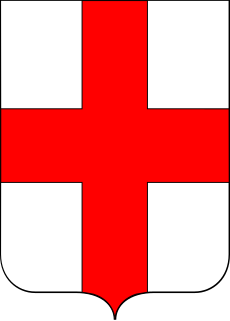
Red and black have always been the club's colors. The founder, Herbert Kilpin, chose them to show the players' strong passion (red) and the fear they would cause in opponents (black). Rossoneri, a common nickname for the team, means "the red & blacks" in Italian, referring to the stripes on their jersey.
Another nickname is the Devil. A red devil was once used as Milan's logo. In Italian football, a Golden Star for Sport Excellence is added above a club's logo after winning 10 league titles. Milan earned its star in 1979.
The official Milan logos have always shown the Flag of Milan (which was originally the flag of Saint Ambrose) next to red and black stripes. The modern badge used today shows the club colors and the flag of Milan, with "ACM" at the top and the founding year (1899) at the bottom. For many decades, no club logo was shown on the match kits, except for the devil's logo in the early 1980s. The club badge started appearing regularly on match strips in the 1995–96 season and has mostly stayed the same since then.
Since it was founded, the AC Milan home kit has been a red and black striped shirt, with white shorts and black socks. Over the years, only small changes were made due to fashion trends. In the early 1900s, the first kit had thin stripes and the city of Milan's badge sewn on. From the 1910s, the stripes became wider. The 1960s saw a return to thin stripes, which lasted until 1985–86, with a brief period of middle-sized stripes from 1980 to 1982. A notable change happened between the 1979–80 and 1980–81 seasons: AC Milan was the first team in Italian football to add players' surnames above their numbers on the shirt.
From the 1986–87 season, under the new owner Silvio Berlusconi, the stripes were made middle-sized again, and the socks became white, matching the shorts. Berlusconi wanted the players to look more elegant and for the kit to be clearly "red and black" on television. This style continued until 1998. Since the 1998–99 season, the kits have been changed yearly.
Milan's away kit has always been completely white, sometimes with red and black decorations. The white away kit is considered lucky in Champions League finals because Milan has won six out of eight finals while wearing all white. They only won one out of three finals in their home strip. The third kit, which is rarely used, changes every year and is usually black with red details.
Anthem and Mascot
The official song of AC Milan is "AC Milan Anthem – Milan Milan". It was first played in 1988 and was created by Tony Renis and Massimo Guantini.
The club's official mascot, designed by Warner Bros., is "Milanello". He is a red devil wearing the AC Milan kit and holding a football.
Stadiums
Milan played its first matches at the Trotter pitch, where the Milan Central railway station is now. It wasn't a proper stadium, as it had no changing rooms or stands. In 1903, Milan moved to the Acquabella pitch, and then to the Porta Monforte pitch in 1906, which had a ticket office and wooden stands. Later, they played at the Velodromo Sempione (1914–1920) and the Viale Lombardia stadium (1920–1926), which was a more modern place.
In 1926, Milan moved to the stadium where they still play today: The San Siro. The stadium is officially called Stadio Giuseppe Meazza, named after a famous player who played for both Milan and Internazionale. It has 75,923 seats. The more common name, "San Siro," comes from the area where it is located. San Siro was built privately by Milan's president at the time, Piero Pirelli. It took about 13 and a half months to build. The club owned the stadium until it was sold to the city in 1935. Since 1947, it has been shared with Internazionale.
The first game played at the stadium was on September 19, 1926, when Milan lost 6–3 in a friendly match against Internazionale. Milan played its first league game there on the same day, losing 1–2 to Sampierdarenese. The stadium, which started with a capacity of 35,000, has been renovated several times. The most recent major renovation was for the 1990 FIFA World Cup, when its capacity was set to 85,700. In 2008, its capacity was reduced to 80,018 to meet new rules.
San Siro is designed specifically for football matches, unlike many other stadiums in Italy that are used for multiple sports. Because the stands are close to the pitch, it is known for its amazing atmosphere during games.
In recent years, there have been discussions about Milan building a new stadium. On September 27, 2023, the chairman Paolo Scaroni announced that the club had proposed building a new 70,000-seat stadium, along with club offices and a museum, in a suburb south of Milan called San Donato Milanese.
Supporters
Milan is one of the most supported football clubs in Italy. Historically, Milan was supported by the working class people of the city, who called them casciavid (meaning "screwdrivers" in the Milanese dialect). Their rivals, Inter Milan, were mainly supported by the wealthier middle class. The oldest organized fan groups in Italian football, Fossa dei Leoni, started in Milan. Today, the main fan group is Brigate Rossonere. Milan fans have not usually had strong political views, but some media have linked them to the left wing, though this view changed a bit during Berlusconi's time as president.
According to a 2010 study, Milan is the most supported Italian team in Europe and the seventh most supported overall, with over 18.4 million fans. In the 2019–20 season, it had the thirteenth highest average attendance among European football clubs.
Club Rivalries
Milan's biggest rivalry is with its city neighbor, Inter Milan. These two clubs play each other in the famous Derby della Madonnina twice every Serie A season. The derby's name refers to the Blessed Virgin Mary statue on the Milan Cathedral, which is a main attraction in the city. The first match between them was in 1908, which Milan won 2–1.
The rivalry was most intense in the 1960s, when both clubs were very successful in Italy and Europe. They won five Serie A titles and four European Cups between them. The matches were exciting, with great managers like Nereo Rocco for Milan and Helenio Herrera for Inter, and star players like Gianni Rivera for Milan and Sandro Mazzola for Inter. The games usually have a lively atmosphere, with many banners from fans. Sometimes, flares are used, which adds to the spectacle but has caused problems, like a Champions League match in 2005 that had to be stopped when a flare hit Milan goalkeeper Dida.
Milan also has a rivalry with Juventus F.C.. This is a rivalry between the two most successful teams in Italy. Milan and Juventus often competed for the top spot in Serie A. Important periods of this rivalry include the early 1950s, when they took turns winning the Serie A title, and the 1990s, when they won eight out of ten league titles. The only time they played each other in a European competition was the 2003 UEFA Champions League final, which Milan won on penalties.
The rivalry with Genoa began early in the 20th century when they often played for the Italian championship. It became more intense in 1995 after a Genoa fan was killed by a Milan supporter. Milan also has rivalries with Fiorentina, Atalanta, and Napoli.
Club Honours
With 32 domestic trophies, Milan is one of the most successful clubs in Italy. They won their first Serie A title in 1901, and their most recent was in 2022. When Milan won its tenth Scudetto (league title), they earned the right to put a star on their jersey.
Milan is the most successful Italian club in international football, having won 20 major international trophies. They are the third most successful in Europe overall, after Real Madrid and Barcelona. They have won the European Cup/Champions League seven times, which is an Italian record and second only to Real Madrid. Their most recent win was in 2007. When Milan won its fifth European Cup in 1994, the club was given the trophy permanently and is allowed to show a special multiple-winner badge on its shirt. The club also shares the record for two wins in the Latin Cup and three wins in the Intercontinental Cup. In 2007, Milan won the FIFA Club World Cup for the first time.
| Type | Competition | Titles | Seasons |
|---|---|---|---|
| Domestic | Serie A | 19 | 1901, 1906, 1907, 1950–51, 1954–55, 1956–57, 1958–59, 1961–62, 1967–68, 1978–79 |
| Serie B | 2 | 1980–81, 1982–83 | |
| Coppa Italia | 5 | 1966–67, 1971–72, 1972–73, 1976–77, 2002–03 | |
| Supercoppa Italiana | 8 | 1988, 1992, 1993, 1994, 2004, 2011, 2016, 2024–25 | |
| Continental | European Cup / UEFA Champions League | 7 | 1962–63, 1968–69, 1988–89, 1989–90, 1993–94, 2002–03, 2006–07 |
| European Cup Winners' Cup | 2 | 1967–68, 1972–73 | |
| European Super Cup / UEFA Super Cup | 5 | 1989, 1990, 1994, 2003, 2007 | |
| Latin Cup | 2s | 1951, 1956 | |
| Worldwide | Intercontinental Cup | 3s | 1969, 1989, 1990 |
| FIFA Club World Cup | 1 | 2007 |
- record
- s shared record
Club Statistics and Records
Paolo Maldini holds the record for the most appearances for Milan, playing 902 official games in total. He also played 647 games in Serie A, which is a record for the league.
Swedish forward Gunnar Nordahl scored 38 goals in the 1950–51 season, with 35 of them in Serie A, setting a club record. He became Milan's all-time top goalscorer, with 221 goals in 268 games. He is followed by Andriy Shevchenko with 175 goals and Gianni Rivera with 164 goals. Rivera is also Milan's youngest ever goalscorer, scoring at just 17 years old.
Legendary coach Nereo Rocco was Milan's longest-serving manager, leading the team for over nine years in the 1960s and early 1970s. He won the club's first European Cup titles. Silvio Berlusconi, who bought the club in 1986, was Milan's longest-serving president for 23 years.
Milan's first official match was in the Third Federal Football Championship, where they lost 3–0 to Torinese. Milan's biggest ever win was 13–0 against Audax Modena in 1914–15. Their heaviest defeat was 0–8 against Bologna in 1922–23.
In the 1991–92 season, Milan became the first team to win the Serie A title without losing a single game. Their unbeaten streak lasted for 58 games, starting in May 1991 and ending in March 1993. This is a Serie A record and the third-longest unbeaten run in top European football.
Since 2007, Milan, along with Boca Juniors, has won more FIFA-recognized international club titles (18) than any other club in the world. They were overtaken by Al Ahly SC from Egypt after their 2014 win.
The sale of Kaká to Real Madrid in 2009 for €67 million (about £56 million) broke the world football transfer record at the time.
Retired Numbers
| No. | Player | Nationality | Position | Milan debut | Last match | Ref |
|---|---|---|---|---|---|---|
| 3 | Paolo Maldini | Centre back / Left back | 20 January 1985 | 31 May 2009 | ||
| 6 | Franco Baresi | Sweeper | 23 April 1978 | 1 June 1997 |
Club Leadership
Chairmen History
Milan has had many chairmen throughout its history. Here is a list of them.
|
|
|
Managerial History
Below is a list of Milan managers from 1900 until today.
|
|
AC Milan Sponsorships
Shirt Sponsors

Emirates has been the main sponsor for Milan's shirt since the 2010–11 season. Before that, German car company Opel sponsored Milan for 12 seasons. For most of those years, "Opel" was on the shirt, but sometimes specific car models like "Meriva" or "Zafira" were shown.
Fashion and Luxury Partnerships
Since Milan is a global fashion capital, AC Milan has worked with Italian high fashion brands. Dolce & Gabbana designed AC Milan's official off-field suits for over 10 years, starting in 2004.
In 2016, Boglioli became their style partner, and then in 2020, Harmont & Blaine took over. In 2021, Harmont & Blaine even released a special AC Milan clothing collection. In 2022, AC Milan partnered with the luxury streetwear brand Off-White.
Beyond fashion, AC Milan also partnered with Italian luxury jewelry company Damiani in 2018. That same year, luxury leather maker Piquadro became the team's "official tech travel" partner. In 2020, Etro became AC Milan's official travel accessories supplier.
Online Betting Partnerships
In 2022, AC Milan announced that the online betting and casino company Betsson would be its official betting partner, especially for Latin America.
Kit Deals
The current shirts are made by Puma. Before Puma, Adidas supplied the kits. The Adidas deal was supposed to last until 2023, but it ended early in October 2017. Before Adidas, the Italian sports company Lotto made Milan's sportswear.
For the 2024-2025 season, AC Milan released a special fourth kit in partnership with Off-White.
| Kit supplier | Period | Contract announcement |
Contract duration |
Value | Notes |
|---|---|---|---|---|---|
| Adidas | 1998–2018 | 9 October 2013 | 2013–2018 | €20 million per year | Original contract duration: 2013–2023 Contract ended early by agreement at the end of the 2017–18 season. |
| Puma | 2018–present | 12 February 2018 | 2018–present | Between €10 million and 15 million per year |
Table of Kit Suppliers and Shirt Sponsors
| Period | Kit manufacturer | Shirt sponsor | |||
|---|---|---|---|---|---|
| Brand | Company | Back | Sleeve | ||
| 1978–80 | Adidas | None | None | ||
| 1980–82 | Linea Milan | Pooh Jeans | Italiana Manifatture | ||
| 1982–83 | Ennerre | Hitachi | Hitachi Europe | ||
| 1983–84 | Olio Cuore | ||||
| 1984–85 | Rolly Go | Oscar Mondadori | Arnoldo Mondadori Editore | ||
| 1985–86 | Gianni Rivera | Fotorex U-Bix | Olivetti | ||
| 1986–87 | Kappa | ||||
| 1987–90 | Mediolanum | ||||
| 1990–92 | Adidas | ||||
| 1992–93 | Motta | ||||
| 1993–94 | Lotto | ||||
| 1994–98 | Opel | General Motors | |||
| 1998–06 | Adidas | ||||
| 2006–10 | Bwin | ||||
| 2010–18 | Emirates | The Emirates Group | |||
| 2018–21 | Puma | ||||
| 2021–23 | Wefox | BitMEX | |||
| 2023–24 | MSC Cruises | ||||
| 2024– | Bitpanda | ||||
Other Sponsors
Since 2013, Banco BPM has been a long-term partner of AC Milan. Skrill became Milan's official global payments partner in 2020. eBay has been AC Milan's official marketplace partner since 2020, and they host an online AC Milan store.
AC Milan Finances
On April 13, 2017, Milan became part of Rossoneri Sport Investment Luxembourg, which bought 99.9% of AC Milan S.p.A. from Fininvest. Li Yonghong became the new chairman. However, Li Yonghong's company lost its ownership after not repaying a loan to Elliott Management Corporation, which then took control of the club in July 2018. Elliott appointed a new board of directors for Milan, with Paolo Scaroni as the new chairman.
According to "The Football Money League" by Deloitte, Milan was the fifth-highest earning football club in the world in the 2005–06 season, with about €233.7 million in revenue. However, they dropped to twelfth place by the 2013–14 season. Forbes magazine ranked Milan as the eighth-wealthiest football club in the world as of 2014, making it the richest in Italian football at that time.
Milan was initially banned from European competitions because of issues with UEFA Financial Fair Play Regulations (rules about how clubs manage their money). However, this ban was lifted after an appeal.
| Year | Revenue | Profit | Total Assets | Equity | Re-capitalization |
|---|---|---|---|---|---|
| 2006 | 305.111 | 11.904 | 287.065 | ||
| 2007 | |||||
| 2008 | |||||
| 2009 (restated) | |||||
| 2010 | |||||
| 2011 | |||||
| 2012 | |||||
| 2013 | |||||
| 2014 | |||||
| 2015 (restated) | |||||
| 2016 | |||||
| 2017 (first half) | |||||
| 2017–18 | |||||
| 2018–19 | |||||
| 2019–20 | |||||
| 2020–21 | |||||
| 2021–22 | |||||
| 2022–23 | |||||
| 2023–24 |
Note: Re-capitalization figures were obtained from item versamenti soci in conto capitale e/o copertura perdite, for 2006 to 2017 financial year
Images for kids
See also
 In Spanish: Associazione Calcio Milan para niños
In Spanish: Associazione Calcio Milan para niños





